Physical Address
304 North Cardinal St.
Dorchester Center, MA 02124
Physical Address
304 North Cardinal St.
Dorchester Center, MA 02124

Before you blow your savings on famous trails, discover which spectacular treks offer Instagram-worthy views without the trust-fund price tag.
You’ve probably scrolled through countless Instagram photos of epic mountain vistas and wondered if those legendary trekking trails are worth the hype—and the hefty price tag. Here’s the truth: some of the world’s most spectacular trails don’t require a trust fund, but they do demand smart planning and realistic expectations. Before you start booking flights to Nepal or Peru, you’ll want to know which trails deliver the most bang for your buck and which ones might leave your wallet as empty as your water bottle.
Standing at 17,598 feet above sea level, Everest Base Camp isn’t just a destination—it’s a badge of honor that’ll cost you far less than you’d expect. You’ll spend roughly $1,200-2,000 for the entire two-week journey, including permits, guides, and accommodation in basic teahouses.
The trek starts in Lukla after a thrilling mountain flight from Kathmandu. You’ll walk through Sherpa villages, cross suspension bridges, and witness jaw-dropping Himalayan views. Don’t rush—proper acclimatization prevents altitude sickness and saves your life.
Pack light but smart: warm layers, sturdy boots, and a good sleeping bag. The teahouses provide meals and beds, so you won’t carry camping gear. Book during spring or autumn for the best weather and clearest mountain views.
This legendary trail consistently ranks among the world’s best hikes for its unmatched combination of culture and natural beauty.
Four days of hiking through cloud forests, ancient ruins, and stone staircases will bring you face-to-face with one of the world’s most iconic archaeological sites. The classic Inca Trail covers 26 miles of challenging terrain, but you’ll need to book months ahead since permits are limited to 500 people daily.
Here’s what you’ll need to budget for:
The trail’s closed every February for maintenance, so plan accordingly. You’ll camp three nights before reaching Machu Picchu at sunrise. Setting up a well-organized basecamp kitchen will make meal preparation much easier during your multi-day trek.
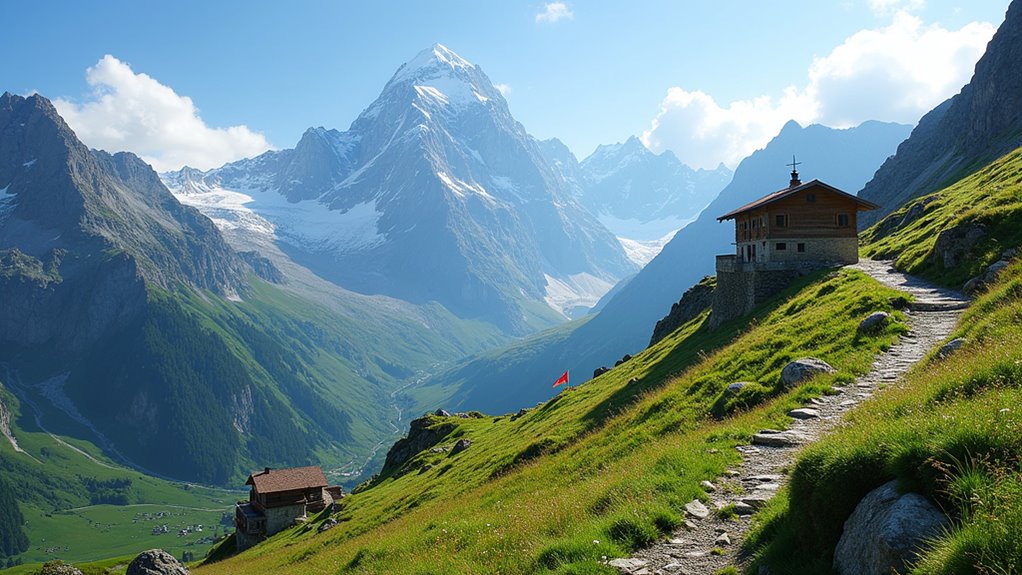
Circling Western Europe’s highest peak, the Tour du Mont Blanc offers 110 miles of spectacular alpine scenery as you trek through three countries in roughly 11 days.
You’ll traverse France, Italy, and Switzerland while experiencing dramatic glacier views, charming alpine villages, and challenging mountain passes.
Budget around €50-80 daily for food and accommodation in mountain huts or guesthouses. Book refuges ahead during peak season (July-September) as they fill quickly.
You’ll need sturdy hiking boots, layered clothing, and rain gear since weather changes rapidly at altitude.
The trail’s well-marked but demanding, with steep ascents and technical sections. Start from Chamonix and hike counterclockwise for easier logistics.
Consider hiring a guide if you’re inexperienced with alpine conditions.
This classic circuit rewards you with unforgettable Mont Blanc vistas.
Before embarking on this epic journey, make sure to review essential hiking tips to maximize your safety and enjoyment on the trail.
Often called Europe’s toughest long-distance trail, the GR20 cuts through Corsica’s rugged mountains for 112 miles of pure adventure. You’ll face granite peaks, alpine lakes, and technical scrambles that’ll test your limits. Don’t expect luxury—this trail demands serious preparation and respect.
Essential GR20 preparation tips:
Budget around €40-50 daily for refuge beds and meals. The northern section’s tougher, while the south offers slightly gentler terrain. You’ll earn every spectacular vista. Remember to follow essential camping tips to ensure your multi-day trek goes smoothly and safely.
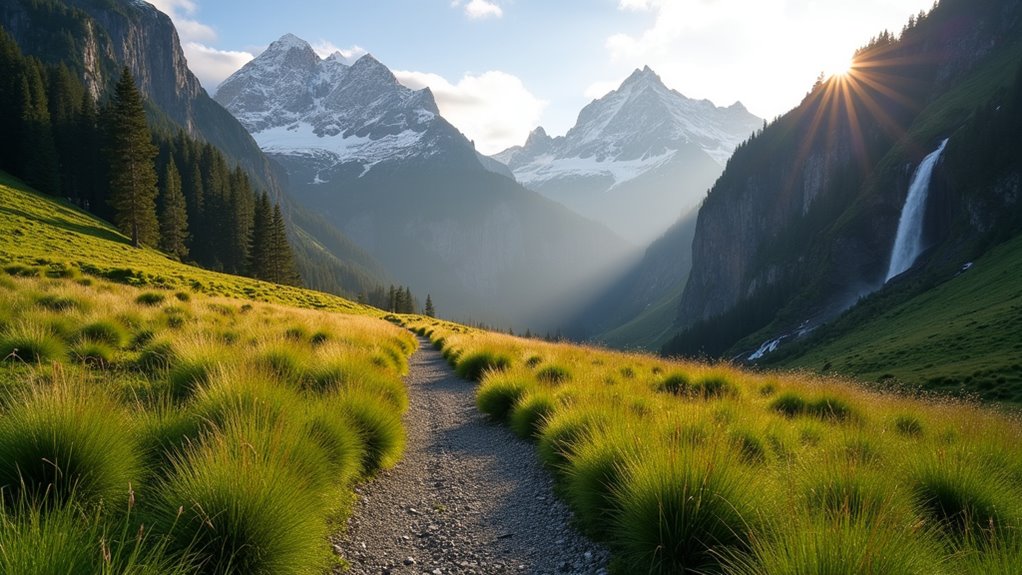
Why do thousands of hikers ballot annually for just 40 daily spots on New Zealand’s Milford Track? You’ll discover the answer across this 53-kilometer journey through Fiordland National Park‘s pristine wilderness.
The four-day trek takes you past ancient rainforests, towering waterfalls, and mirror-like lakes. You’ll cross the challenging MacKinnon Pass at 1,154 meters, where panoramic alpine views reward your effort.
The track’s crown jewel awaits at Milford Sound – dramatic fjords carved by glaciers over millennia.
Budget around $200-300 for hut accommodations and transport. Book months ahead through New Zealand’s Department of Conservation. Pack waterproof gear; Fiordland receives substantial rainfall year-round.
The controlled numbers preserve this fragile ecosystem while ensuring you’ll experience genuine solitude in one of Earth’s last wilderness frontiers. Families planning to tackle this adventure should research appropriate kids camping gear to ensure young hikers stay comfortable and safe throughout the multi-day journey.
From New Zealand’s controlled wilderness, we head to Chile’s crown jewel where reservations aren’t required but preparation certainly is.
You’ll tackle the famous W Circuit in Torres del Paine, where Patagonian winds can knock you sideways and weather changes faster than your mood after skipping breakfast. This 50-mile trek delivers glacial lakes, granite towers, and wildlife encounters that’ll make your Instagram followers jealous.
Budget-smart trekkers should pack these essentials:
You’ll camp at designated sites or stay in refugios. Book accommodations early during peak season (December-February) unless you’re comfortable potentially sleeping under stars.
For those seeking a more comfortable basecamp experience, consider combining your trek with caravan camping adventures at nearby established campgrounds before or after tackling the circuit.
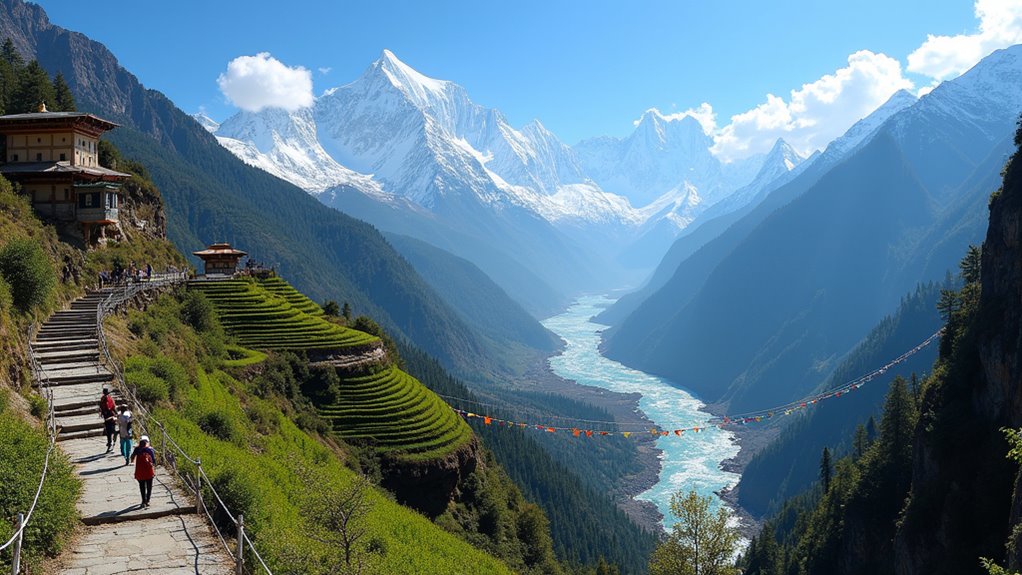
What happens when you combine altitude sickness, yak traffic jams, and dal bhat for breakfast, lunch, and dinner? You get Nepal’s legendary Annapurna Circuit – a 230-kilometer trek that’ll test your limits and your wallet.
You’ll climb from subtropical valleys to the 5,416-meter Thorong La Pass, crossing diverse landscapes that’ll make your Instagram followers jealous. Budget around $25-30 daily for teahouse accommodation and meals. The dal bhat (rice and lentils) gets repetitive, but it’s filling and cheap.
Start in Besisahar and finish in Pokhara. October-November and March-May offer the clearest mountain views. Bring layers – you’ll experience four seasons in one day. Don’t rush the ascent; altitude sickness isn’t worth the bragging rights. Book nothing in advance except your flight to Kathmandu. Pack proper rain gear and learn essential tent camping techniques, as mountain weather can turn unpredictable and you may need to camp during monsoon conditions.
Trading Nepal’s teahouses for Tanzania’s camping adventure, Kilimanjaro’s Northern Circuit offers Africa’s highest peak without the crowds of popular routes like Machame or Marangu. You’ll spend 8-9 days circling the mountain, giving your body essential time to acclimatize while exploring diverse ecosystems from rainforest to alpine desert.
Budget around $2,500-3,500 for permits, guides, and camping gear. The route’s length makes it pricier, but you’re paying for solitude and safety through gradual elevation gain.
Key advantages include:
You’ll traverse the dramatic Moir Hut area and witness stunning sunrise views that justify every challenging step toward Uhuru Peak. The authentic tent camping experience on this route provides unmatched connection to the mountain’s raw wilderness compared to more commercialized accommodation options.
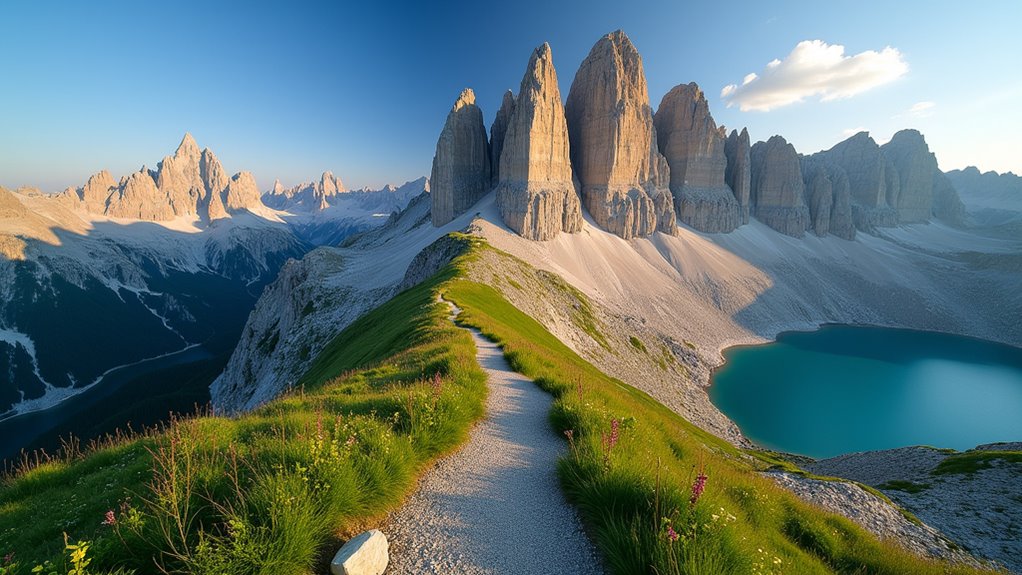
While Africa challenges you with altitude, Italy’s Dolomites Alta Via 1 rewards hikers with legendary mountain huts and jaw-dropping limestone spires that’ll make your Instagram followers weep with envy.
This 75-mile trek connects Lago di Braies to Belluno through UNESCO World Heritage terrain, taking 10-12 days to complete.
You’ll sleep in rifugios (mountain huts) serving hearty meals for €25-40 per night, eliminating camping gear weight. Book accommodations months ahead—these huts fill fast during peak season (July-September).
Pack layers since weather changes quickly at altitude.
The trail demands moderate fitness with some technical sections requiring via ferrata gear. Daily distances average 4-6 hours of hiking.
Budget €50-70 daily including meals and lodging. Cable cars provide bailout options if weather turns nasty.
For those traveling with children, consider practicing family camping activities beforehand to build hiking endurance and outdoor skills.
From Europe’s cozy mountain huts, we head to America’s Sierra Nevada, where the John Muir Trail stretches 211 miles from Yosemite Valley to Mount Whitney—the highest peak in the contiguous United States.
Trading European comfort for raw American wilderness, the legendary John Muir Trail beckons adventurers across 211 miles of Sierra Nevada grandeur.
You’ll need serious preparation for this wilderness adventure. Unlike European trails with convenient lodging, you’re carrying everything on your back for 2-3 weeks. Budget around $1,500-2,000 for permits, gear, and resupply boxes.
Essential planning steps:
The payoff? Pristine alpine lakes, granite peaks, and unmatched solitude through America’s most spectacular high country.
For hikers seeking more comfort during their wilderness adventures, self-contained camping trailers offer an alternative basecamp option for accessing trailheads and enjoying amenities between backcountry segments.
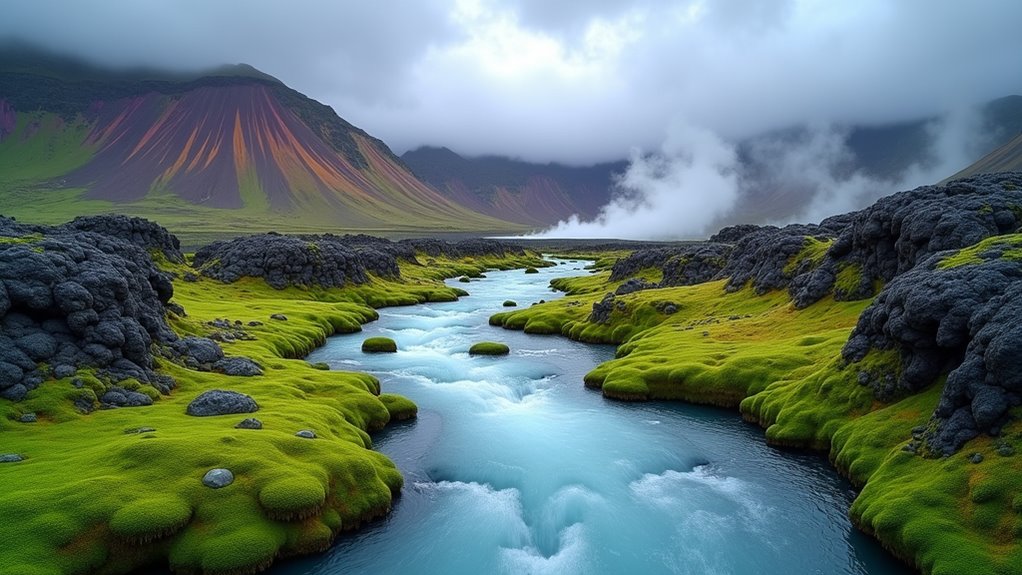
Why settle for ordinary hiking when you can trek through an alien landscape that looks like Mars? Iceland’s Laugavegur Trail delivers otherworldly scenery without leaving Earth. You’ll walk 34 miles through steaming hot springs, rainbow-colored mountains, black volcanic deserts, and glacial valleys.
The trail connects Landmannalaugar to Thórsmörk, typically taking 3-4 days. Mountain huts cost around $60 per night, making it budget-friendly compared to hotels. Book early—they fill up fast during summer season.
Pack warm, waterproof gear since weather changes rapidly. You’ll cross rivers, so bring quick-dry boots. The trail’s well-marked but demanding, with steep climbs and loose volcanic rock.
Don’t expect cell service or stores along the route. Bring all food and supplies from Reykjavik. The payoff? You’ll witness landscapes so surreal they’ve doubled for alien planets in movies.
Given Iceland’s unpredictable weather conditions, having the right essential gear for staying warm can make the difference between an unforgettable adventure and a miserable experience.
If you’re craving alpine scenery without the crowds of Patagonia, New Zealand’s Routeburn Track delivers pristine wilderness at a fraction of the cost. This 32-kilometer trail connects Fiordland and Mount Aspiring National Parks, showcasing dramatic peaks, emerald lakes, and ancient beech forests.
You’ll need to book huts well in advance during peak season (October-April), but shoulder seasons offer better availability and fewer crowds.
Book Routeburn huts early for peak season, or choose shoulder months for better availability and solitude on the trail.
The track typically takes 2-3 days, with comfortable Department of Conservation huts providing beds and cooking facilities.
Since the huts don’t provide treated water, carrying reliable water purifiers is essential for safe drinking throughout your multi-day journey.
Budget-friendly tips for your Routeburn adventure:
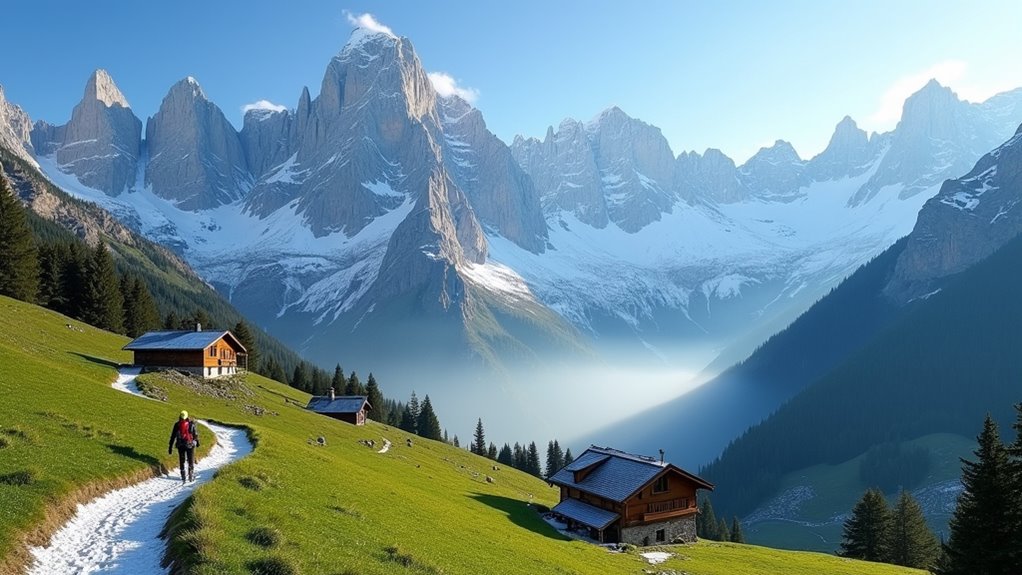
While most people assume the famous Tour du Mont Blanc will break the bank, you can tackle Europe’s premier alpine circuit without emptying your wallet.
You’ll traverse three countries—France, Italy, and Switzerland—covering 105 miles of stunning alpine terrain in 7-11 days.
Stay in mountain refuges instead of hotels to slash accommodation costs. Pack lunches from local bakeries rather than eating at expensive mountain restaurants.
Start from Chamonix and follow the classic counterclockwise route through dramatic valleys, pristine glacial lakes, and flower-filled meadows.
Book refuges early, especially during peak season (July-August). Carry euros for all three countries, though some huts accept cards.
You’ll witness Western Europe’s highest peak from every angle while experiencing authentic alpine culture across borders.
This trek makes an excellent addition to any European backpacking adventure, offering incredible value for budget-conscious travelers seeking world-class mountain experiences.
You’ve got the world’s greatest hiking trails at your fingertips—thirteen paths that’ll stretch your legs and your budget in the best possible way. Don’t let these adventures remain pipe dreams gathering dust on your bucket list. Pack light, plan smart, and remember: the mountains aren’t going anywhere, but your chance to explore them affordably might. Lace up those boots and turn these trail maps into passport stamps.